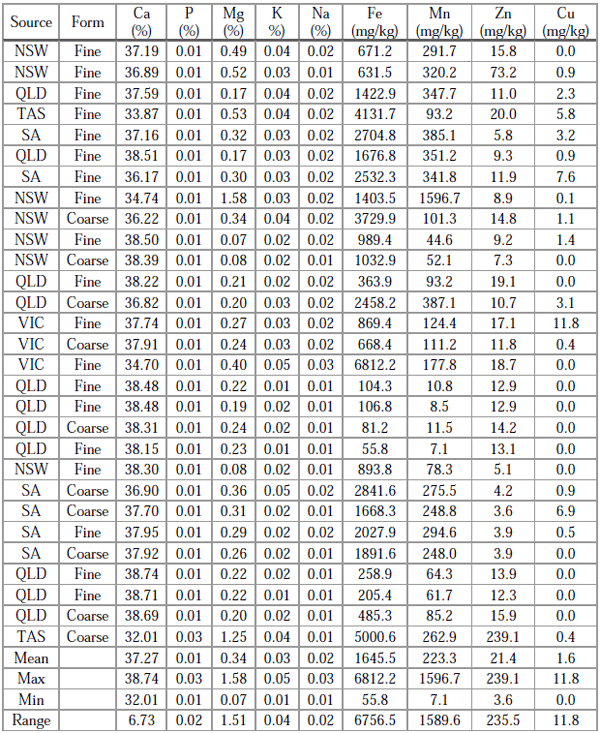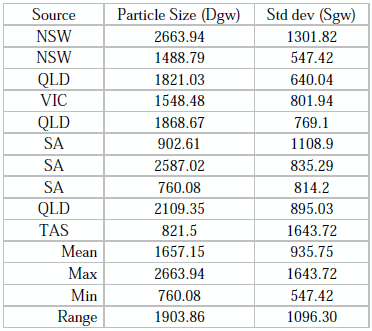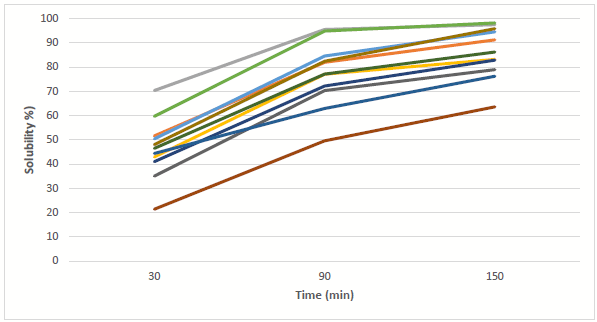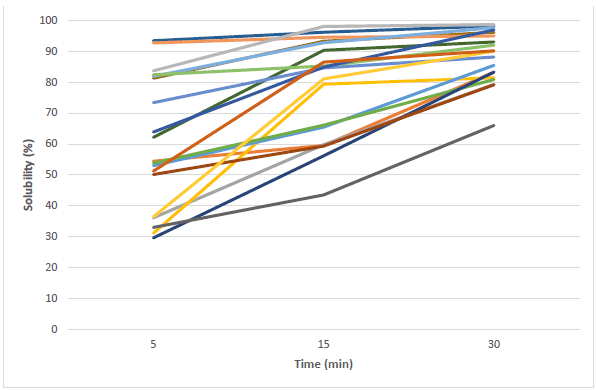I. INTRODUCTION
Calcium (Ca) is a dietary essential mineral for poultry and the requirements for poultry have been investigated extensively for more than 75 years (Driver et al., 2005). Calcium is the most prevalent mineral in the body and is important for many physiological processes such as enzyme activation, intracellular signalling, acid base balance, eggshell formation and bone mineralisation (Li et al., 2017). Almost 99% of Ca is stored in the skeleton as hydroxyapatite (Proszkowiec-Weglarz and Angel, 2013); hence the importance of providing sufficient dietary Ca to meet this requirement has dominated much of poultry nutrition’s focus. However, the objective of providing adequate Ca for skeletal integrity has often led to an oversupply of Ca in poultry diets which may have unintended antinutritive effects. High dietary Ca concentrations have been reported to impede the availability of minerals such as P, Mg, Mn, and Zn, reduce the efficacy of phytase through the formation of Ca-phytate complexes (Wilkinson et al., 2014).
Demonstrating the influence of dietary Ca concentration on endogenous and exogenous phytase efficacy, Tamim et al. (2004) showed in broilers that were fed diets without supplemental Ca (0.2% total Ca) or exogenous phytase that 69% of phytate-P was hydrolysed (at the ileal level) from corn-soy based diets. However, when birds were fed diets containing 0.7% total Ca, the birds’ capacity to hydrolyse phytate-P was reduced to 25%, representing a 44% reduction in endogenous phytase efficacy. Moreover, when diets containing 0.2% total Ca were supplemented with a 6-phytase (500 FTU/kg), phytate-P disappearance increased to be greater than 75%. However, when diets with 0.7% total Ca were supplemented with phytase, phytate-P digestibility only increased to 59%, a result that was considerably lower than for the low Ca diet with no supplemental phytase. It should be noted that the antinutritive effects of 0.7% total Ca observed are lower than the total Ca recommendations for broiler starter and grower diets (Aviagen, 2022). It is therefore important to manage the total amount of Ca in poultry diets.
II. LIMESTONE QUALITY
Limestone (CaCO3) is primarily added to poultry diets as a cost-effective source of Ca. Limestone in feed can contribute greater than 50% of total Ca consumed and in all-vegetable diets, this value may be as high as 70% (Gilani et al., 2022). Concomitant to the limestone added at the feed mill, limestone may also be used as a carrier in vitamin-mineral premixes and may also be used as a flow agent such as in soybean meal. This may result in significantly more limestone and therefore Ca being added to the ration than intended. The quality of these other sources of limestone is much less likely to be understood yet the same considerations should apply. The utilisation of dietary Ca and P depends on their concentration and availability from the feed that is modulated via intestinal, renal and skeletal mechanisms (Li et al, 2017). Calcium digestibility and metabolism are influenced by several factors, including phosphorus and vitamin D so that any deficiency or excess of one may significantly change the metabolism of the other (Gilani et al., 2022). Recent research has shown that limestone quality (beyond the traditional quality characteristics) can influence Ca and P digestibility and is an important determinant in poultry nutrition (Kim et al., 2019).
a) Mineral composition
Limestone has a maximum Ca concentration of 40.04% based on chemical composition and molecular weight (Gilani et al., 2022), yet it is rare to see commercial limestone this pure. Typically, the Ca concentration of limestone used in animal feeds varies from 38-39% for high quality limestone but it is also possible to see examples with much lower Ca concentrations. Plumstead et al. (2020) reported that the analysed Ca content of limestone ranged from 30.4-40.0%. Lower quality limestone (~34% Ca) with higher levels of impurities such as magnesium (Mg), iron (Fe), manganese (Mn), zinc (Zn) and copper (Cu) may also be encountered and potentially bring more to consider when formulating. As mineral nutrition advances and the effect of excess minerals, for example Fe, are better understood, the amount of Fe from limestone may need to be considered to minimise the proliferation of pathogenic microbes in the gastrointestinal tract (Nairz et al., 2018).
b) Particle size and solubility
Other components contributing to the quality of limestone are particle size and solubility. Two broad categories of particle size, coarse (> 1000 μm) and fine (< 1000 μm), are ubiquitously used in poultry nutrition. However, these classifications are not authoritative. In vitro limestone solubility has been linked to in vivo solubility and Ca digestibility in layers. Broiler studies have shown increased particle size results in increased Ca digestibility (Kim et al., 2019). Rapidly soluble limestone is thought to be less beneficial for broilers as more ionisable Ca is present in the gizzard and proventriculus, presenting greater opportunity for chelation with phytic acid (Kim et al., 2019). More recently, research has shown that limestone particle size is not in and of itself a reliable predictor of solubility rates, and that the geology of the limestone rock also contributes to the rate of solubility. So, while limestone at first glance may appear relatively innocuous, due to the inherent differences in purity, particle size and solubility between limestone sources, inclusion of limestone (from all sources) in poultry diets should be managed closely.
c) Australian context
Recently, 29 limestone samples were collected from Australian sources and analysed for mineral concentration (Table 1), particle size (Tables 2 and 3) and solubility (Figures 1 and 2) according to the methods of Kim et al. (2019). While limestone is generally thought to contain 38% Ca, the results of this survey show there is substantial variation in Ca concentration and should be accounted for when formulating poultry diets. Of the limestone samples analysed, the highest Ca concentration reported was 38.7% and the lowest was 32.0 %. This represents a difference of 6.7% and may lead to inadequate Ca being provided in the diets if book values are used.
Table 1 - Mineral concentration of samples of limestone used in Australian poultry diets.
Table 2 - Mean particle size of Australian coarse limestone samples used in poultry diets.
Table 3 - Mean particle size of Australian fine limestone samples used in poultry diets.
Figure 1 - Solubility (%) over time of coarse limestone samples used in Australian poultry diets.
Figure 2 - Solubility (%) over time of fine limestone samples used in Australian poultry diets.
Of the other analysed minerals, variable amounts of Fe, Mn and Mg were also detected. Concentrations of Fe ranged from 55.8-6812 mg/kg, Mn ranged from 7-1596 mg/kg and Mg ranged from 0.07-1.58%. The negative effects of high amounts of divalent cations in diets on phytate destruction and phytase efficacy are well established. However, the effects of excess Fe and its role in the proliferation of pathogenic microbes are perhaps less widely known. The mineral composition results presented herein support the recommendation to closely manage limestone inclusion and account for variations in mineral composition when formulating.
The mean particle size distribution of the Australian limestone samples surveyed are shown in Tables 2 and 3. As expected, there is considerable variation in mean particle size and distribution. Particle size alone is thought to be highly correlated with in vitro solubility and generally, may be useful for this purpose. However, mean particle size does not entirely explain differences in limestone solubility. For example, of the coarse limestone samples, instances of lower solubility at 30 minutes were not correlated with particle size. In fact, the limestone sample with the highest particle size was more soluble at 30 minutes than other samples with lower particle sizes. Comparing the rates of solubility between coarse and fine limestone samples also revealed that some fine limestone samples had lower overall solubility at 30 min compared to some coarse samples. These findings concur with those reported by Kim et al., (2019).
d) Limestone quality: Digestible Ca recommendations
Despite the voluminous amounts of research published that have investigated dietary Ca concentrations required for optimum growth and performance, there has been no general agreement on what the appropriate concentrations of dietary Ca should be and, importantly, little information exists on digestible Ca recommendations. The concept of formulating poultry diets using available or digestible Ca values is not a new concept (Walk et al., 2021). Yet somewhat quizzically, Ca stands alone in poultry nutrition for it remains one of, if not the only, nutrients formulated using total dietary values. Even calcium’s nutritional partner, P, is formulated to digestible or available values. For Ca to remain being formulated to a total dietary concentration belies the importance of calcium to the bird as well as the potential for dietary Ca to have antinutritive effects.
Several reasons exist that have undoubtedly contributed to the lack of digestible Ca recommendations, perhaps most notably the inextricable link with P, which makes it difficult to accurately determine digestible Ca requirements. Other reasons cited include the lack of digestible Ca values for common raw materials used in poultry feeds, as well as discrepancies in analysed Ca values of (Walk et al., 2021). These same authors also reference the challenges in interpreting digestible Ca value between research groups
The need to formulate diets close to birds’ nutrient requirements is not a new concept; however, as the poultry industry moves toward refining formulations to more accurately reflect their requirements, more information pertaining limestone and Ca are required. Historically, Ca has been over supplied in broiler diets. This is perhaps a product of its relatively inexpensive cost (relative to other raw materials) as well as the objective to provide adequate Ca for bone mineralisation. However, this view only considers the benefits of Ca and does not account for the antinutrient effects of excess Ca. The data presented herein supports the findings of other published work that shows considerable variation in limestone mineral composition and solubility profiles. These may have an impact on Ca digestibility and may need to be considered when formulating. Anwar et al. (2016) showed in birds fed diets containing 0.9% total Ca from one of three different limestone sources had differing Ca digestibility coefficients (0.54-0.61) and in the review by Walk et al. (2021) it is suggested that the variability in Ca digestibility from limestone may be influenced by particle size, solubility as well as the in vivo assay methodology. Formulating to digestible Ca will need to account for these considerations.
Presented at the 34th Annual Australian Poultry Science Symposium 2023. For information on the next edition, click here.

















.jpg&w=3840&q=75)